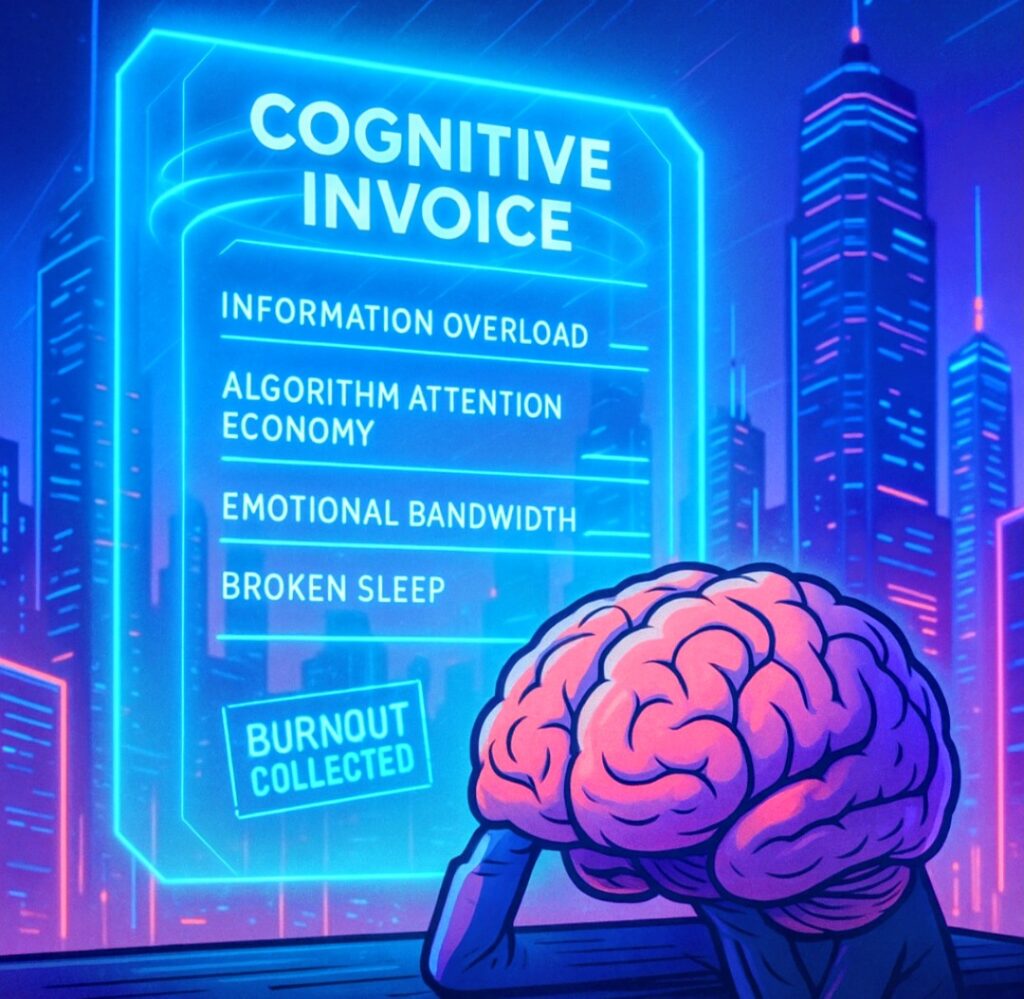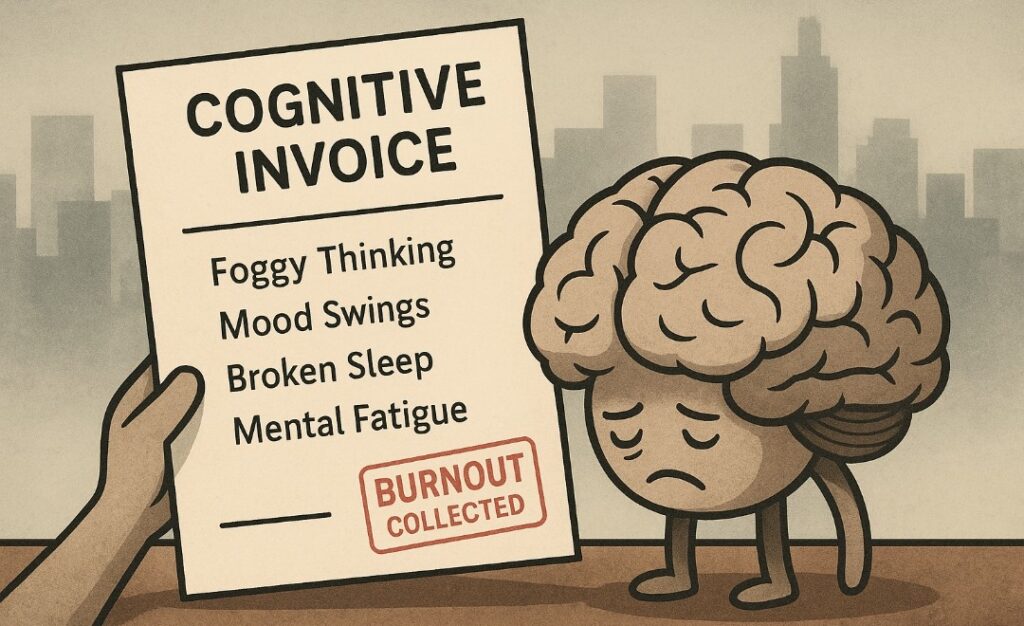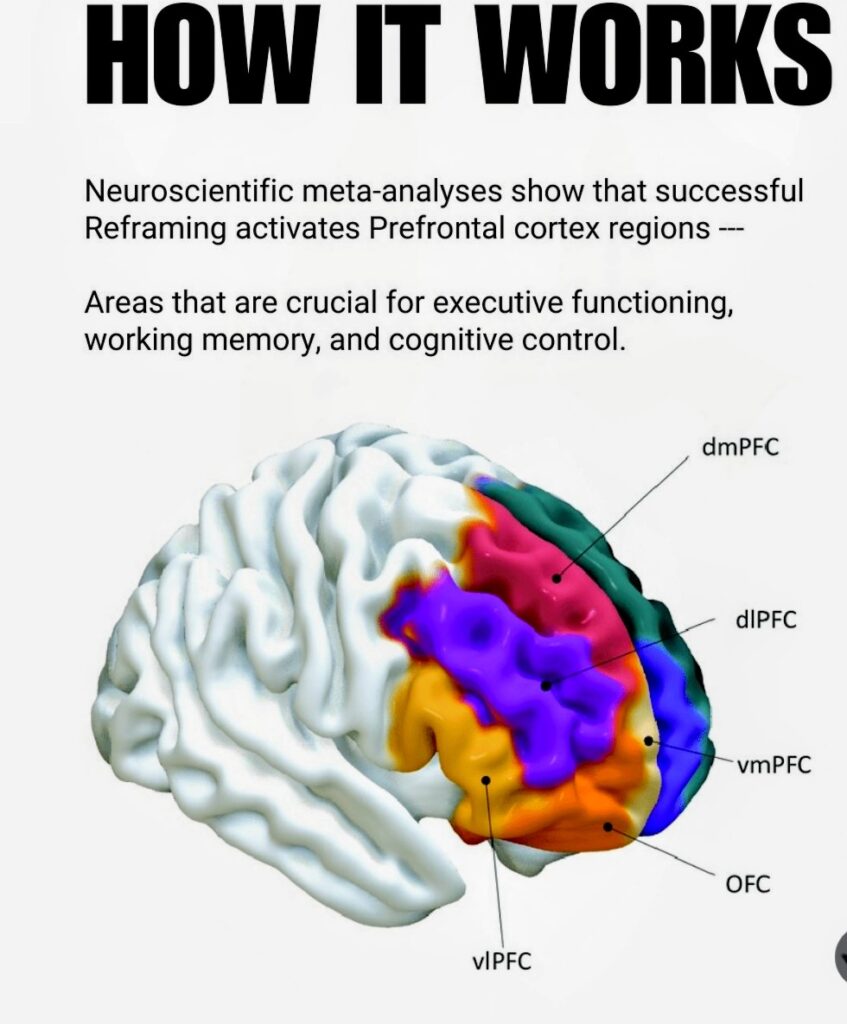Cognitive Invoice

We have so much emotional weights than necessary. Our body can not carry all these burdens. Also, our brain can not digest unprocessed thoughts. Hence, emotional fat appears and it accumulates in the blood-brain barrier. So, How does industrial burnout happen? How do we receive Cognitive Invoice in the end of the day ? What is the relations between industrial burnout and cognitive invoice ?

The entire digital world’s data is designed to target the limbic system, located in the middle part of the brain. Algorithms, personal profile analysis, and psychosocial profiling are designed to personalize and target content and ads to the individual.(Lymbic Capitalism) Industrial dopamine servers constantly collect data through algorithmic attention economy. Therefore, our emotional bandwidth is commodified. In this point, we can describe Cognitive Invoice as the daily transaction that’s embedded in our daily life.
Cognitive Invoice is the price we pay for dopamine-driven-micro-hits. It is actually billed as distraction, procastination and decision fatigue. When we look at Invoice Items, we can see ”endless scrollling’ and ‘short-form dopamine loops.’ As a result, it emerged as shallower thinking and delayed deep work.

Another point that we need to emphasize is that occuring The Age Of Self in modern society. Unfortunately, this reality has created the erosion of the self. Rather than collective way of thinking, industrial society turn into themselves. More clearly, we’ve been drafted into an economy of constant self-display. For instance, the global self-improvement market is already worth $45.7 billion (2024), and it’s on track to double by 2033. (Source: NESAR)
Under these circumstances, everyone is seeking a different resources for implementing some ideas into what they want. However, we can not turn our knowlege into applicable concrete steps. Cognitive Invoice threatened by industrial dopamine server centers. It targets our mind and capabilities that we need to protect.

The Biggest Cognitive Item: Cognitive Adaptation Tax
On the other hand, Cognitive Invoice consist of endless bursts of stimulation. We call it Invoice Items for all of them. Invoice Items like excessive notifications, algorithmic noise, interrupted deep sleep cycles cause the costs like techno-stress, fragmented attention span and mood instability.
Foggy thinking + mood swings+ broken sleep+ constant sense of mental fatigue = Cognitive Invoice.
Total Due : Burnout, frustration, and reduced well-being.
Payment Method: Time, energy and emotional resilience.
Our brain is constantly processing uncertanity. For this, our brain needs cognitive items. Without items, our brain feels drained. When we face the uncertanity, we ruminate the ideas that we hold in hand. In this moment, Self-Talk emerges as massive toolkit that we can use. It is the distinctive structure for the human brain.

In particularly, minds crave the ideas in multiple ways. While we start to consume information outwardly, we digest it inwardly by apply it like a plumber on the other hand. If we need to make an arrangement about our consumption, there must be consistent toolkit for this.
Self-Talk structures emotion by labeling, reframing, regulating, repairing and narrating it. This enables raw sensations turn into pyschological architecture.Self-talk is not just random chatter in your head. It’s the command center of your emotional regulation system. When stress, uncertainty, or anger strike, the way you speak to yourself determines whether you take control—or the leak gets worse.
This is the most powerful tool for sharper memory and learning mechanism for brain. Like Neural Networks, there is feedforward process in data flows. Data flows from input to output layers, data is classified through a fully connected newtork via cycle repeats until accuracy is achieved.

Cognitive Reframing : Plumber Kit
Think Aloud Protocol describes the positive effects on our brains of expressing those inner voice within us., making them tangible and audible. Research conducted at Harvard shows that thinking out loud makes the prefrontal cortex in our brain, the planing and decision- making center more active. When we vocalize our thoughts, we can focus %40 better than when we just think them.
We can establish a structured and effective dialogue with ourselves. In this way, we can create emotional distance and make more rational decisions. This technique allows you to look at yourself from the outside.

Like a plumber, we can tap this toolkit into what we learned. In order to solve the problems, we can act like plumber who have a toolkit at any time. A plumber is a man who identify what the problems are. He repairs the mechanical parts. Measuring, cutting, bending and threading pipes using hand and power tools or machines. They repair various defects. In this point, correct diagnoses is essential for the maintaning and recovering. Their mind brows the problems and they are forced to find a solution. They carry out packaged ideas and implement these ideas to the problems.


